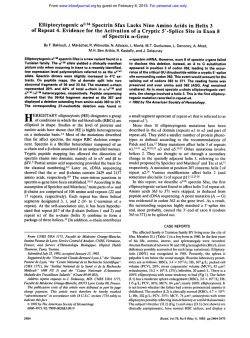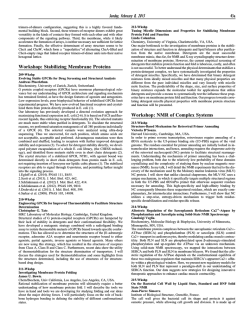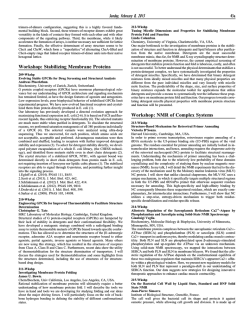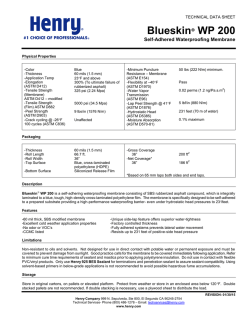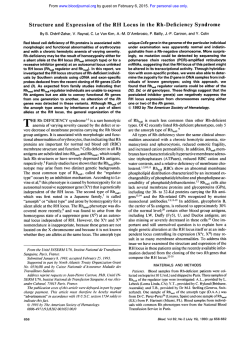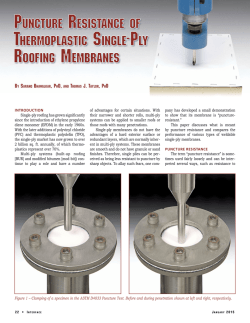
The Instability of the Membrane Skeleton in Thalassemic Red Blood
From www.bloodjournal.org by guest on February 6, 2015. For personal use only. The Instability of the Membrane Skeleton in Thalassemic Red Blood Cells By J. Yuan, A. Bunyaratvej, S. Fucharoen, C. Fung, E. Shinar, and S.L. Schrier The thalassemias are a heterogeneous group of disorders characterized by accumulation either of unmatched a or P globin chains. These in turn cause the intramedullary and peripheral hemolysisthat leads t o varying anemia. A Partial explanation for the hemolysis came out of our studies on material propertiesthat showed that &thalassemia (B-thal) intermedia ghosts were very rigid but unstable. A clue t o this instabilitycame from theobservation that the spectrinl band 3 ratio was lowin red bloodcells (RBCs) of Splenectomized p-thal intermedia patients.The possible explanations for theapparent decrease in spectrin content includeddeficient or defective spectrin synthesis in thalassemic erythroid precursors or globinchain-induced membrane changes that lead t o spectrin dissociation from the membrane during ghost preparation. To explore the latteralternative, samples from different thalassemic variants were obtained, ie, 8-thal intermedia, HbEIP-thal, HbH (cu-thal-l/a-thal-2), HbHlConstant Spring (CS),and homozygousHbCSlCS. We searched for thepresence of spectrin in the firstlysate of thestandard ghost preparation. Normal individuals and patientswith autoimmune hemolytic anemia, sickle cell anemia, and anemia due t o chemotherapy served as controls. Using gradientso- dium dodecyl sulfate-polyacrylamide gel electrophoresis analysis. no spectrin was detected in identical aliquotsof the supernatants of normals andthese control samples. Varying amounts of spectrin were detected in the firstlysate supernatants of almost all thalassemic patients. The identification of spectrin was confirmedby Western blotting using an affinity-purified, monospecific, rabbit polyclonal antispextrin antibody. Relative amounts of spectrin detected were as follows in decreasing order: splenectomized P-thal intermedia including HbEIpthal; HbCSlCS; nonsplenectomized p t h a l intermedia, HbHlCS; and, lastly, HbH. These findings were generally confirmed when w e used an enzyme-linked immunosorbent assay technique t o measure spectrin in the first lysate. Subsequent analyses showed that small amounts of actin and band 4.1 also appeared in lysates of thalassemic RBCs. Therefore, the three major membrane skeletal proteins are, t o a varying degree, unstably attached in severe thalassemia. From these studies we would postulate that membrane association of abnormal or partially oxidized aglobin chains has a more deleterious effect on the membrane skeleton than do p-globin chains. 0 1995 by The American Societyof Hemeto/ogy. E by Western blotting and quantitative laser densitometry (data not shown) In some experiments, we used an affinity-purified anti-band 4.1 antibody kindly provided by Dr Joel Chasis (Lawrence Berkeley Laboratory, Berkeley, CA). Rabbit polyclonal antibody against band 3 was a generous gift from Dr Philip Low (Purdue University, Lafayette, IN). Mouse monoclonal antiactin antibodies were purchased from Amersham (Arlington Heights, IL). The secondary antibodies used in Western blotting were a horseradish peroxidase-linked goat antirabbit IgG or goat antimouse IgG obtained from DAKO (Carpinteria, CA). Reagents used in the determination of spectrin by enzyme-linked immunosorbent assay (ELISA) are described below. All other reagents were the best analytical grade available. Collection of blood. Venous blood was obtained from thalassemic patients and normal controls and shipped on ice in citrate phosphate dextrose or acid citrate dextrose from Bangkok, Thailand under protocols approved by the Thalassemia Center, Siriraj Hospital KTACYTOMETRIC studies have shown abnormalities of the material properties of red blood cells (RBCs) and their membranes in the several forms of thalassemia.lB2 The membranes of both a-thalassemia (a-thal)and p-thalassemia (p-thal) variants are quite rigid, but the membrane instabilities are In severe a-thal (hemoglobin-H disease) the membranes are hyperstable, whereas in severe p-thal (p-thalintermedia) the membranes are unstable, particularly in samples from patients who have been splenectomized.’ Membrane stability is thought to be controlled by the content and function of its skeleton, which is principally composed of ternary complexes of spectrin, actin, and band 4.1 arranged in apparent hexagonal array^.^‘^ Spectrin dimer self association is defective in severe forms of both a-thal and P-thal.7 In severe p-thalintermedia, the spectrinhand 3 ratio is low; this observation pointed to a deficiency of spectrin in the skeleton8 accounting for the instability. There are several possible causes for such a deficiency, including deficient synthesis of spectrin in thalassemic erythroid precursors, abnormal spectrin function in forming the ternary complex, and abnormal function of those proteins that bind the spectrin-rich skeleton to the membrane? In these experiments, we explored the tightness of spectrin binding to the membrane. Ordinarily during ghost preparation by standard stepwise hypotonic hemolysis,” virtually no spectrin is detectible in the first hemolysate. Therefore, we looked for the abnormal appearance of spectrin in the first hemolysate of the standard ghost membrane preparation of several sorts of thalassemic RBCs. MATERIALS AND METHODS Materials. High-quality sodium dodecyl sulfate (SDS) was purchased from BDH (Poole, UK). Rabbit polyclonal anti-band 4.1 and antispectrin were generated as described previously.8.”,’2As previously shown,8.” the monospecific antispectrin used reacts 1.7 times more against a spectrin than against p spectrin, as determined Blood, Vol86, No 10 (November 15). 1995: pp 3945-3950 Fromthe Thalassemia Center, Siriraj Hospital, Bangkok, Thailand; the Department of Pathology, Ramathibodi Hospital, Bangkok, Thailand; Magen David Adom, Tel Hashomer, Israel; and the Division of Hematology, Stanford University School of Medicine, Stanford, CA. Submitted November 7, 1994; accepted July 3, 1995. Supported by National Institutes of Health Grant No. R01 DK13682, by European Community Grant No. EEC TS-CT92-0081, and by the Prajadhipok Rambhai Barni Foundation. Presented in abstract form at the 35th annualmeeting of the American Society of Hematology, St Louis, MO, December 1993 (Blood 82:361a, 1993 [abstr, suppl I ] ) . Address reprint requests to Stanley Schrier, MD, Division of Hematology, Stanford University School of Medicine, Stanford, CA 94305. The publication costs ofthis articlewere defrayed in part by page charge payment. This article must therefore be hereby marked “advettisement” in accordance with 18 U.S.C.section 1734 solely to indicate this fact. 0 1995 by The American Society of Hematology. 0006-4971/9.5/8610-OOO6$3.00/0 3945 From www.bloodjournal.org by guest on February 6, 2015. For personal use only. 3946 (Bangkok, Thailand) and the Department of Pathology, Ramathibodi Hospital (Bangkok, Thailand). These samples were compared with samples from controls and patients with autoimmune hemolytic anemia, sickle cell anemia, and chemotherapy-induced anemia at Stanford University Medical Center (Stanford, CA). This latter group of patients consisted of patients entering complete remission in acute myeloid leukemia (AML) who no longer require RBC transfusion. Blood was drawn under protocols approved by Stanford University Committee on Human Subjects in Research. Preparation ofhemolysate. The RBCs were washed three times in phosphate-buffered saline (PBS) to remove plasma and buffycoat. The cells were then incubated at 37°C for 1 hour with the protease inhibitors 2 mmol/L diisopropylflurophosphate (DIT), 10 pg/mL leupeptin, and 10 pg/mL pepstatin and again washed twice in PBS and packed. The hematocrit (Hct) of the cells was measured and a volume of RBC suspension was added that approximated 1 mL of 100. These RBCs were lysed in 20 mLof RBCs withanHctof lysis buffer consisting of 5 mmol/L sodium phosphate, I mmol/L EDTA, pH 8.0, and 20 pg/mL phenylmethyl sulfonyl fluoride (PMSF) to inhibit proteolysis. The lysed cells were centrifuged at 12,000 RPM, 17,400g for 20 minutes. The first lysate was quantitatively collected for analysis. SDS-polyacrylamide gel analysis (SDS-PAGE). Ten millilters of first lysates was centrifuged at 12,000 RPM, 17,400g for 15 minutes. One hundred fifty microliters of clear supernatant was added to standard solubilizer solution and loaded on 6%to 18% gradient SDS-PAGE gels and electrophoresed. The gel was stained with Commassie brilliant blue and destained in 7%acetic acid solution.'." Western blot analysis. Samples were electrophoresed on SDSPAGE, transferred onto nitrocellulose, and then reacted with rabbit polyclonal antibodies to spectrin, band 4.1, and band 3 (all three at 1:500 dilution in PBS) and mouse monoclonal antibodies to actin (1:SOO dilution in PBS). The reaction was developed by adding either horseradish peroxidase-linked goat antirabbit IgG or antimouse IgG ( I : 1,000 dilution in PBS), followed by the addition of the substrate 4-ch10ronaphthol.l~~'~ Quantijcation of spectrin in the first hemolysate. The amounts of spectrin appearing in first lysate were determined as follows. The supernatant from the first lysate underwent SDS-PAGE as described above and a fresh normal ghost preparation was included in each gel to establish the region where a- and P-spectrin migrate. From each supematant sample, strips of the gel that contained these regions were carefully cut and placed in separate I-mL Eppendorf tubes. A piece of gel equal in area to the strips containing spectrin served as a control. One milliliter of 25% pyridine solution was added to each tube. The tubes were capped and agitated overnight. The next day, spectrophotometer readings were taken at 605 nm and recorded. The absolute amount of spectrin in the first hemolysate was estimated as follows. The protein content and concentration of a fresh ghost sample was determined by the Lowrymethod standardized using bovine serum albumin. The sample was then subjected to SDSPAGE exactly as described above, stained with Commassie brilliant blue, andthen analyzed by laser densitometry. The densitometer data provided the absolute concentration of spectrin present in the ghost sample. A spectrin standard curve wasthen established by adding a serial dilution of this ghost preparation to sequential wells and performing SDS-PAGE. After staining, the spectrin containing areas were eluted into pyridine (as above) and the absorption at 605 nm was plotted versus the known content of spectrin onthe gel. The values of spectrin used for this standard curve were based on our prior analyses of thalassemic hemolysates and were chosen to contain and overlap the values initially observed. Using interpolation, the absolute values for spectrin in the patients' first hemolysates were determined. Wehad added a precisely measured volume of packed RBCs to each lysate. Each patient's resulting ghosts were YUAN ET AL also subjected to SDS-PAGE and the proportion of spectrin was calculated by laser densitometry. Therefore, we could determine the proportion of spectrin that appeared in each first hemolysate. This calculation wasbased on the following presumptions: 1 mL of packedRBCs (Hct at a theoretical 100) consists of IO"' normal RBCs and, when converted to ghosts, contains 7 mg of membrane protein of which a- and P-spectrin (bands 1 and 2) comprise 30% or 2.1 mg of spectrin. ELISA. To confirm more definitively the amount and proportion of spectrin that dissociates from RBC membranes during hypotonic lysis, an ELISA method was used. For this experiment an entirely new shipment was obtained from Bangkok consisting of samples from patients not previously analyzed and including two normal shipment controls. Several preliminary experiments were performed to establish a standard curve spanning the anticipated spectrin concentration. Standards were run in duplicate, whereas patient samples were performed in triplicate. One hundred microliters of lysates and spectrin standard (Sigma Chemicals, St Louis, MO) was coated directly onto a 96-well ELBA plate (ICN Biochemicals, Horsham, PA) and incubated overnight at 4°C. After blocking with 200 pL of 5% bovine serum albumin (BSA) in PBS per well for 2 hours at 37"C, theplate was washed four times with 0.05% Tween 20 (Sigma Chemicals) in PBS. To each well we added 100 pL of the Ig fraction of our monospecific polyclonal antispectrin antibody (diluted 1:250 with 5% BSA in PBS), which was followed by incubation at 37°C for 2 hours. The plate was again washed and 100 pL of peroxidaselinked donkey antirabbit Ig antibody (1:5,O00 dilution with 1% BSA in PBS; Pierce, Rockford, IL) was added and incubated at 37°C for I hour. After a final fourfold wash with 0.05% Tween 20 in PBS, the plate was developed using the o-phenylenediamine (OPD) ELISA detection kit (Pierce). The plate was read at 490 nm using an ELISA plate reader (Flow Laboratories, McLean, VA). Patient hemolysates were prepared and analyzed when the samples arrived; these results are presented in Table 2. Three days later, another set of hemolysates was prepared from the same RBCs and run again with substantial agreement (data not shown). RESULTS of j r s t lysate. After lysing a precise volume of packed RBCs, the first supernatant was collected and analyzed on a gradient SDS-PAGE, as shown in Fig I A and B. Normal controls do not have any visible protein in the a- or P-spectrin region of the gel. In contrast, all of the thalassemic samples show varying amounts of visible spectrin in the first lysate, indicating that some spectrin was dissociated from the membrane cytoskeletal network during the first hypotonic lysis. The number of patients with each thalassemic variant studied is listed in Table I. Other patient controls studied included autoimmune hemolytic anemia (n = 3), sickle cell anemia (n = 2), and chemotherapy-induced anemia (n = 3; Table 1); the results are shown in Fig 2. No protein bands in the spectrin region were visible in these patient's lysates. Conjnnation of the presence of spectrin. To be sure that the bands seen on the gels were indeed spectrin, Western blotting analyses were performed (Fig 3). The bands seen in our thalassemic lysates were, in fact, immunoreactive spectrin and none was detected in our normals or patient controls. Quantijcation of the spectrin in the hemolysate. To estimate the amount of the spectrin that was dissociated from the membrane, the protein bands in the spectrin region were Spectrincontent From www.bloodjournal.org by guest on February 6, 2015. For personal use only. INSTABILITY MEMBRANE CELLS IN THALASSEMIC BLOOD RED 3947 Table 1. Diseases Studied A No. v - 1 F- NI AHA Chemotherapy-induced anemia (AML) 4-8- ss a 3 3 2 HbElfl-thal (S) HbE/O-thal (NS) Hb CSlCS Hemoglobin H (U-thal-lln-thal-2) Hb HlCS (r-thal-l trait Abbreviations: NI, normal individuals; AHA, autoimmune hemolytic anemia; SS, sickle cell anemia; HbEIB-thal (S), splenectomized 0-thal intermedia; HbElfi-thal (NS), nonsplenectomized a-thal intermedia; Hb CSlCS, homozygous Hb Constant Spring; HbHlCS, hemoglobin HlConstant Spring. B v+ '6 ' +G,+""++G& G + +q @ @ @ @ + 'rv @04 Spcmn *+ "6 $ ,+ 4~ c\ "I" Fig 1. SDS-PAGE of first lysate of thalassemic samples from Bangkok (A and B). The RBCs were washed and lysed as described. One hundred fifty microlitersof the firstlysate was collected and solubilized in SDS, separated electrophoretically on 6% to 18% nonlinear gradient polyacrylamidegels, and stainedwith Commassie blue. cut out and eluted intopyridine. The results are shown in dissociated from Fig 4. in which the proportion of spectrin the membrane by the first hypotonic lysis step is indicated along with disease severity as manifested by thepatient's hemoglobin concentration.Four different thalassemic groups areshownandcontrasted withseveralnormal individuals and 2 patients with a-thal trait. The splenectomized P-thal patients have the most severe anemia while having the highest proportion of spectrin dissociation. Homozygous hemoglobin Constant Spring (CS) RBCs show considerable spectrin dissociation, but the anemia is quite modest. Because these results were critical for our observation, an ELlSA method wasalso used todetect spectrin in the first lysate. The results are shown in Table 2 and are consistent with the resultsreported abovefor the semiquantitative method. However. the patients with homozygous Hb CS/CS in this shipment did not have a s much spectrin dissociation as seenpreviously. The generally high values of spectrin dissociationseen in P-thal intermediawereconfirmed as were the low values for classical HhH disease. Detectioil of other memhrme proreins in the first Iyscrtc. With the evidence that some spectrin dissociates from the membrane in the several forms of severe thalassemia tested, it became important to determine if spectrin was unique in this regard. We therefore tested the first lysate for the presence of actin and band 4.1 using Western blotting and found both proteins in virtually all of our thalassemic patient samples and little if any in normal patients or patient controls " . - Fig 2. SDS-PAGE of samples from local and shipment controls. Patientssamples included sickle cell anemia, anemia, and a patient with AML recovering from indudion with an elevated reticulatecount withno longer transfusion dependent. From www.bloodjournal.org by guest on February 6, 2015. For personal use only. YUAN ET AL 3948 ting confirms thepresenceofspectrin (Fig 3). Spectrin in the first hemolysate of thalassemic RBCs was measured and the amounts in decreasing order were as follows: splenectomized P-thal intermedia including HbEIP-thal: Hb CS/CS; nonsplenectomized 0-thal intermedia; HbH/CS; and, lastly, HbH disease (Fig 4). ELISA measurements generally confirmed these findings. The fact that the 0-thal variants and some of the CS variantsproducerelativelymorespectrin dissociation than did classical HbH disease (a-thal-lla-thal2) suggests thatthebinding of an a-globin chain to the membrane (the excessa globin in P-thal and the a-Con.sfrrrrf Spring in HbH/CS disease and in some patients HbCS/CS)" produces relatively more spectrin dissociation than does Pglobin chain binding. It would be convenientto speculate that the spectrin dissociation occurring in splenectomized P-thal intermedia RBCs accounts for the membrane instability seen in the ghosts of these RBCs. However. we cannot make that obvious linkage because some Hb CS variants show similarly large amounts of spectrin dissociation and their membranes are known to be hyperstable.lS Our initial observations were confined to an analysis of spectrin in the first hemolysate, because spectrin bands could be seen on SDS-PAGE. No bands migrating in the position of band 4.1 or actin could be visualized on standard SDSPAGE. However, because both of these membrane skeletal proteins are present of approximately 15% of the content of spectrin, their presence might be below the detectability of SDS-PAGE analysis with Commassie blue staining. Therefore, we searched for the presence of these membrane skeletal proteins in Western blotting and found small amounts of both band 4.1 and actin in the first lysates of virtually all of our severely affected thalassemic patients. No band 4.1 or actin was found in thelysates of normals orour patient controls. Furthermore, no band 3 was found in any of our patients or controls, and the band 3 content of membranes is equal to or greater than that of spectrin. Therefore, we concluded that the major transmembrane protein, band 3, is stablyinserted into the membrane butthatthe membrane skeletal proteins represented by spectrin, actin, and band 4.1 Fig 3. Western blotting studies of first lysates. After SDS-PAGE separations, the samples were transferred to nitrocellulose and reacted first with rabbit antispectrin antibodies and then with horseradish peroxidase-conjugatedgoat antirabbit antibodies. The immunoblots were developed using 4-chloronaphtholas substrate. (Figs S and 6). To determineif there was a general membrane instability, we analyzed the first lysate in Western blotting in patients. usingananti-band 3 antibodyandfoundnone normals. or patient controls (data not shown). DISCUSSION In normal RBCs and in RBCs from patients with sickle cell anemia, autoimmune hemolytic anemia, and chemotherapy-induced anemia, spectrin is tightly bound to the membrane skeleton and to transmembraneproteins and very little, if any, appears in the first hemolysate.'" In both a-thal and P-thal, spectrin appears in the first hemolysate (Fig IA and B), indicating a degree of instability of spectrin binding to the skeleton or to the transmembrane proteins. Western blot- Subject 6.5 6.9 6.3 10.6 HbCSCS 10.1 HbCYCS 9.3 HbCSCS 8.5 9.1 7.5 HbWCS HbWCS (S) HbWCS K 10.0 HbH 7.7 HbH 13.1 Alpha-lhal 1 lrail 12.5 Alpha-lhal l trait 14.1 NI 12.2 NI ND NI 4. 4 % Spectrin in Hemolysate 8 10 Fig The amount of spectrin that dissociates from the membrane is indicatedfor five specific thalassemic variants along with the patients' hemoglobin content. From www.bloodjournal.org by guest on February 6, 2015. For personal use only. MEMBRANEINSTABILITY IN THALASSEMIC REDBLOODCELLS 3949 Table 2. Percentage of Spectrin in Hemolysate Determined by ELSA Disease Tvoe Hab IqldL) Soectrin 1%) HbE/O-thal (NS) HbE/O-thal (NS) HbE/O-thal (NS) HbE/O-thal (NS) HbCS/CS HbCS/CS HbH/CS HbH HbH NI NI 10.1 7.9 7.9 6.4 9.8 10.6 10.9 6.8 9.7 16.6 17.0 3.9 6.2 11.8 4.6 2.3 2.6 2.4 1.9 2.0 1.3 1.3 are unstably attached to the membrane in all of the thalassemic variants tested. An alternative and unlikely explanation for our findings isthat thalassemic RBCs contain cytosolic spectrin, band 4.1, and actin. This possibility is highly unlikely given the recent studies of membrane assembly.'6 Furthermore, if cytosolic spectrin were present. it would be more likely to be aspectrin thatis synthesized at three times the rate as Pspectrin. However, inspection ofFig IA and B shows that, if anything, P-spectrin appears to be present in somewhat larger amounts than a-spectrin. The observation is further buttressed by the fact that our antispectrin antibody reacts +Actin Fig 5. Western blotting studies of patients and control lysates. After SDS-PAGE separations,the samples were transferred to nitrocellulose and reacted first with antiactin monoclonal antibodies and then with peroxidase-conjugated goat antimouse antibodies. The immunoblots were developed using 4-chloronapthol as substrate. 4=band 4.1 Fig 6. Western blotting studiesof patients and control lysates. After SDS-PAGE separations,the samples were transferred to nitrocellulose and reacted first with affinity-purified anti-band 4.1 and then with peroxidase-conjugated goat antirabbit antibodies. The immunoblots were developed using 4-chloronaptholas substrate. 1.7 times morewith a-spectrin thanwith P-spectrin (see Materials and Methods). It is not clear why 0-spectrin may be present in somewhat greater concentration than a-spectrin in our thalassemic lysates. It maybe that the proteases that degrade a-spectrin are very active in thalassemic RBCs in vivo, leaving relatively larger amounts of P-spectrin behind. Therefore, three membrane skeletal proteins are dissociated from thalassemic RBCs when challenged by hypotonic lysis. The degree of spectrin instability does not account for the membrane instability detected by ektacytometry. The reported defective spectrin dimer self association could also contribute to the membrane instability.' The accumulation of a-globin chains at themembrane (either excess a in severe P-thal or a CS in some of the HbCS variants) presumably destabilizes the membrane skeleton more than the @globin chain accumulation that occurs in classical Hb-H disease. At this point, it is not clear how this membrane instability could contribute to the peripheral hemolysis seen in thalassemia. It is likely that the accumulation of the globin chains at the membrane or their oxidation products produces derangement sufficient to account for as much as 10% of spectrin dissociation during hypotonic lysis. REFERENCES 1. Schrier SL. Rachmilewitz E. Mohandas N: Cellular and membrane properties of alpha and beta thalassemic erythrocytes are different: Implication for differences in clinical manifestations. Blood 74:2 194, I989 2. Schrier SL: Thalassemia: Pathophysiology of red cell changes. Annu Rev Med 45:21 I . 1994 3. Fortier N. Snyder LM, Garver F. McKenney J, Mohandas N: The relationship between in vivo generated hemoglobin skeletal protein complex and increased red cell membrane rigidity. Blood 71:1427,1988 4. Chasis JA, Mohandas N: Erythrocyte membrane deformability and stability: Two distinct membrane properties thatare independently regulated by skeletal protein associations. J Cell Biol 103343. 1986 S. Liu SC, Derick LH: Molecular anatomy of thered blood cell membrane skeleton: Structure-function relationships. Semin Hemato1 29:231.1992 From www.bloodjournal.org by guest on February 6, 2015. For personal use only. 3950 6. Liu SC, Derick LH, Zhai S, Palek J: Uncoupling of the spectrin-based skeleton from the lipid bilayer in sickle red cells. Science 252574, 1991 7. Lamchiagdhase P, Wilairat P, Sahaphong S, Bunyaratvej A, Funcharoen S: Defective spectrin dimer self-association in thalassemic red cells. Eur J Haematol 38:246, 1987 8. Shinar E, Shalev 0, Rachmilewitz EA, Schrier SL: Erythrocyte membrane skeleton abnormalities in severe beta thalassemia. Blood 70: 158, 1987 9. Shinar E, Rachmilewitz EA, Lux SE: Differing erythrocyte membrane skeletal protein defects in alpha and beta thalassemia. J Clin Invest 83:404, 1989 IO. Bennett V: Proteins involved in membrane-cytoskeleton association in human erythrocytes: Spectrin,ankyrin, and band 3. Methods Enzymol 96:313, 1983 11. Conboy JG, Chan JY, Chasis JA, Kan YW, Mohandas N: Tissue- and development-specific alternative RNA splicing regulates YUAN ET AL expression of multiple isoforms of erythroid membrane protein 4.1, J Biol Chem 266:8273, 1991 12. Advani R, Sorenson S, Shinar E, Lande W, Rachmilewitz E, Schrier SL: Characterization and comparison of the red blood cell membrane damage in severe human alpha and beta thalassemia. Blood 79:1058, 1992 13. Schrier SL, Mohandas N: Globin-chain specificity of oxidation-induced changes in red blood cell membrane properties. Blood 79: 1586, 1992 14. Smith DK, Palek J: Sulfhydryl reagents induce altered spectrin self-association, skeletal instability, and increased thermal sensitivity of red cells. Blood 62:1190, 1983 15. Aljurf M, Mohandas N, Fucharoen S, Bunyaratvej A, Schrier SL: Volume and cellular material properties of Hb-Constant Spring (CS). Blood 82:223a, 1993 (abstr, supp 1 ) 16. Hanspal M, Palek J: Biogenesis of normal and abnomla1 red blood cell membrane skeleton. Semin Hematol 29:305, 1992 From www.bloodjournal.org by guest on February 6, 2015. For personal use only. 1995 86: 3945-3950 The instability of the membrane skeleton in thalassemic red blood cells J Yuan, A Bunyaratvej, S Fucharoen, C Fung, E Shinar and SL Schrier Updated information and services can be found at: http://www.bloodjournal.org/content/86/10/3945.full.html Articles on similar topics can be found in the following Blood collections Information about reproducing this article in parts or in its entirety may be found online at: http://www.bloodjournal.org/site/misc/rights.xhtml#repub_requests Information about ordering reprints may be found online at: http://www.bloodjournal.org/site/misc/rights.xhtml#reprints Information about subscriptions and ASH membership may be found online at: http://www.bloodjournal.org/site/subscriptions/index.xhtml Blood (print ISSN 0006-4971, online ISSN 1528-0020), is published weekly by the American Society of Hematology, 2021 L St, NW, Suite 900, Washington DC 20036. Copyright 2011 by The American Society of Hematology; all rights reserved.
© Copyright 2026
